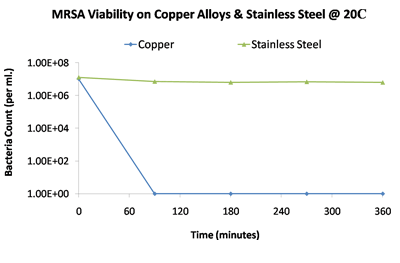Program Background
Hospital-acquired infections (HAIs) have grave consequences for patients in both military and civilian healthcare facilities. The Centers for Disease Control and Prevention estimates that more than two million HAIs occur each year in the USA, resulting in nearly 100,000 deaths and costing some $30 billion annually. Frequently touched surfaces in healthcare facilities, such as bedrails, bed trays, remote controls and call buttons, chairs, doorknobs, push plates, faucet handles and sinks, medical device controls, intravenous poles and other items can be transfer points for the spread of pathogenic microbes.
 Bacteria living in a scratch on a sanitized stainless steel surface
Bacteria living in a scratch on a sanitized stainless steel surfaceThe Copper Touch Surfaces Program comprises a series of three clinical trials to determine whether copper touch surfaces will decrease HAIs in patients. The trials will examine bacterial loads and rates of infection related to three specific indicator organisms: methicillin-resistant Staphylococcus aureus (MRSA), vancomycin-resistant Enterococci (VRE) and Acinetobacter baumannii (A-baum) in various clinical environments including intensive care units, cancer and general medicine rooms such as gastrointestinal care units.
Why Copper? Copper and copper alloys (e.g., brasses, bronzes, copper nickels, copper-nickel-zincs) have intrinsic antimicrobial properties with well documented efficacy against a wide range of pathogens, including multi-disease resistant bacteria. The Copper Development Association (CDA) has conducted a series of laboratory tests under Environmental Protection Agency (EPA) Good Laboratory Practices (GLP) protocols that have provided evidence that copper surfaces kill microbes in a matter of hours (More info on copper.org).

To date, no other material has been qualified to make a public health claim under the EPA guidelines. This research shows that within a couple of hours, copper alloys reduce pathogenic bacteria such as MRSA, Escherichia coli (E. coli) O157:H7, Pseudomonas aeruginosa, Staphylococcus aureus, and Enterobacter aerogenes by 99.9%.
Frequently touched surfaces in healthcare facilities can serve as reservoirs for pathogenic microbes. Cleaners and disinfectants can kill these organisms, when the organisms can be reached. However, too often, due to scratches in the surfaces, the cleaning solution may not reach the organism. Please note that the use of copper alloys is a complement to good hygienic and disinfection practices and must not replace them.
Common materials, such as stainless steel, used for touch surfaces products in healthcare facilities have no intrinsic properties that eliminate microbial contamination. Furthermore, copper has been used in hospital settings safely and effectively for more than two decades as a means to prevent the growth of Legionella pneumophila, the agent responsible for the pneumonias associated with Pontiac Fever and Legionnaire’s disease.